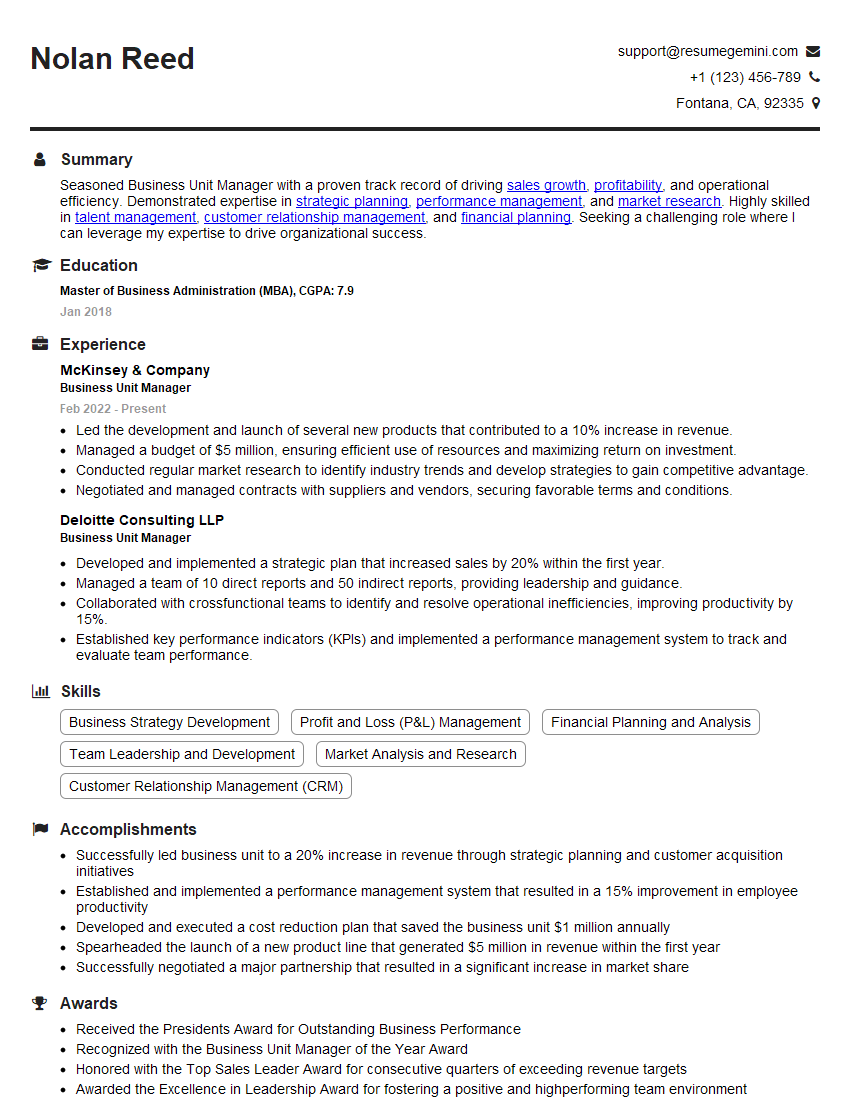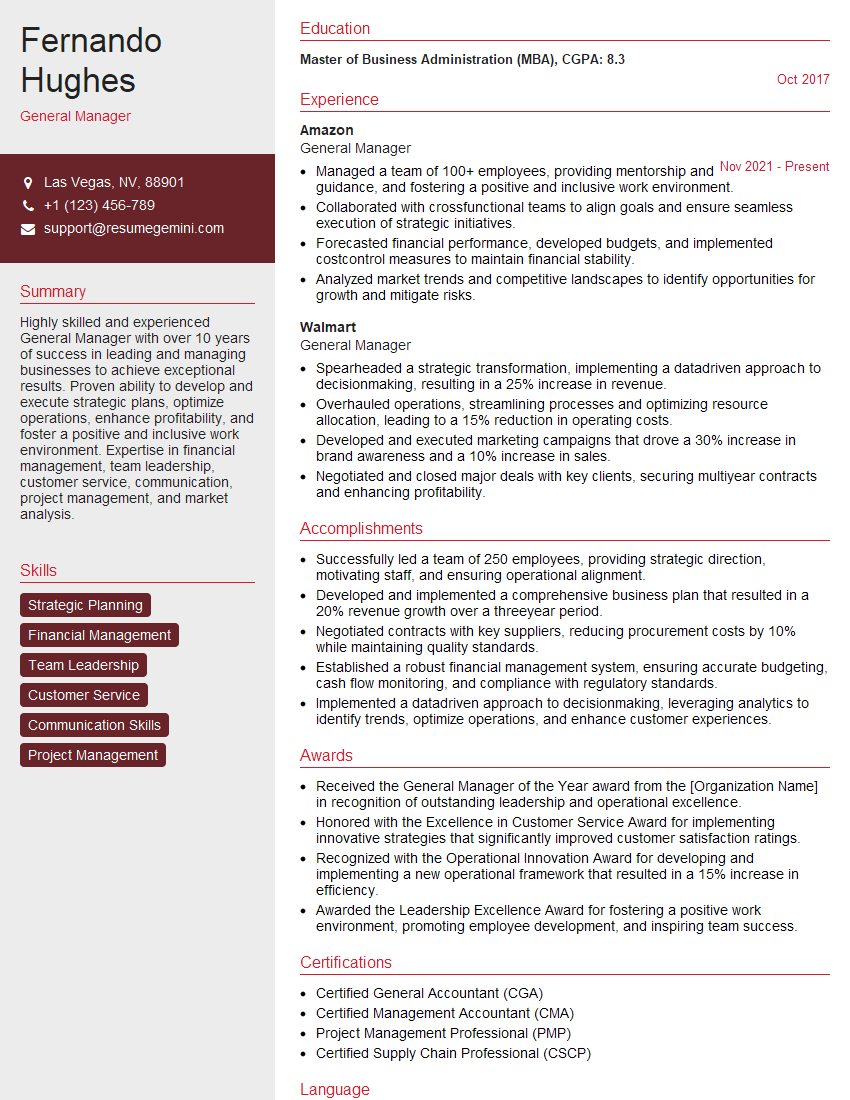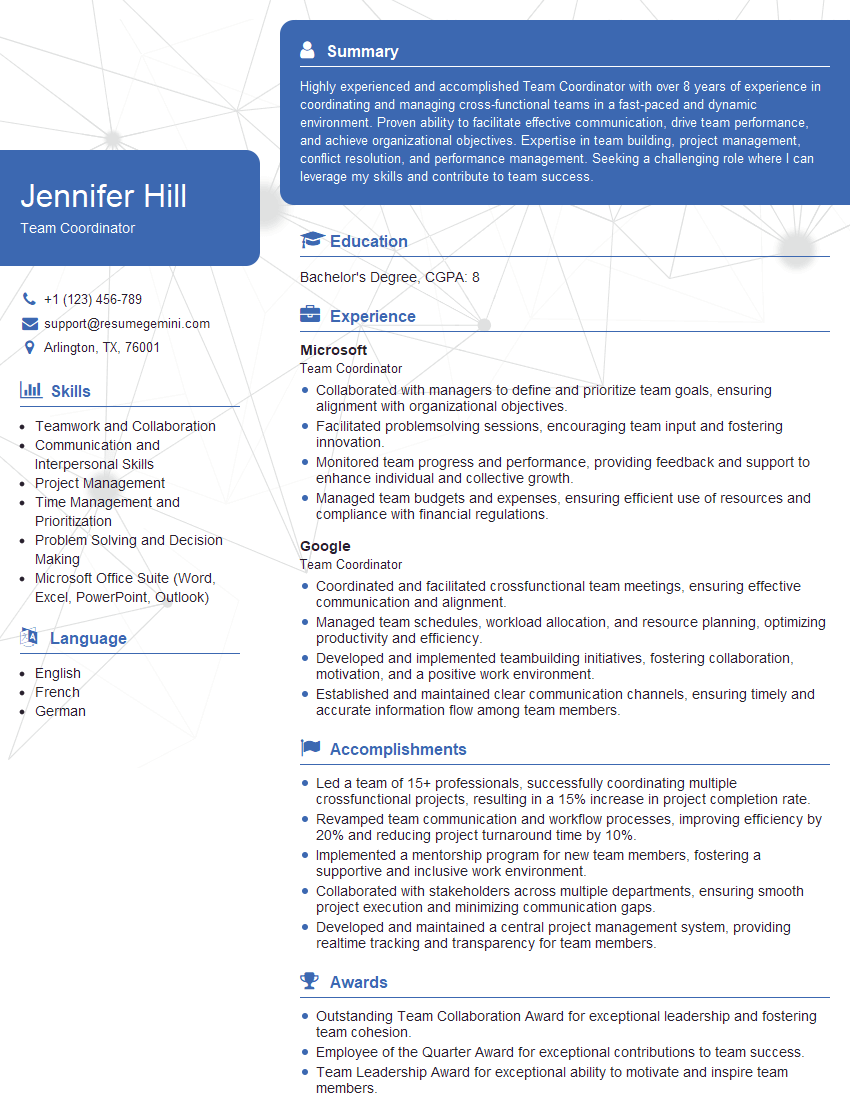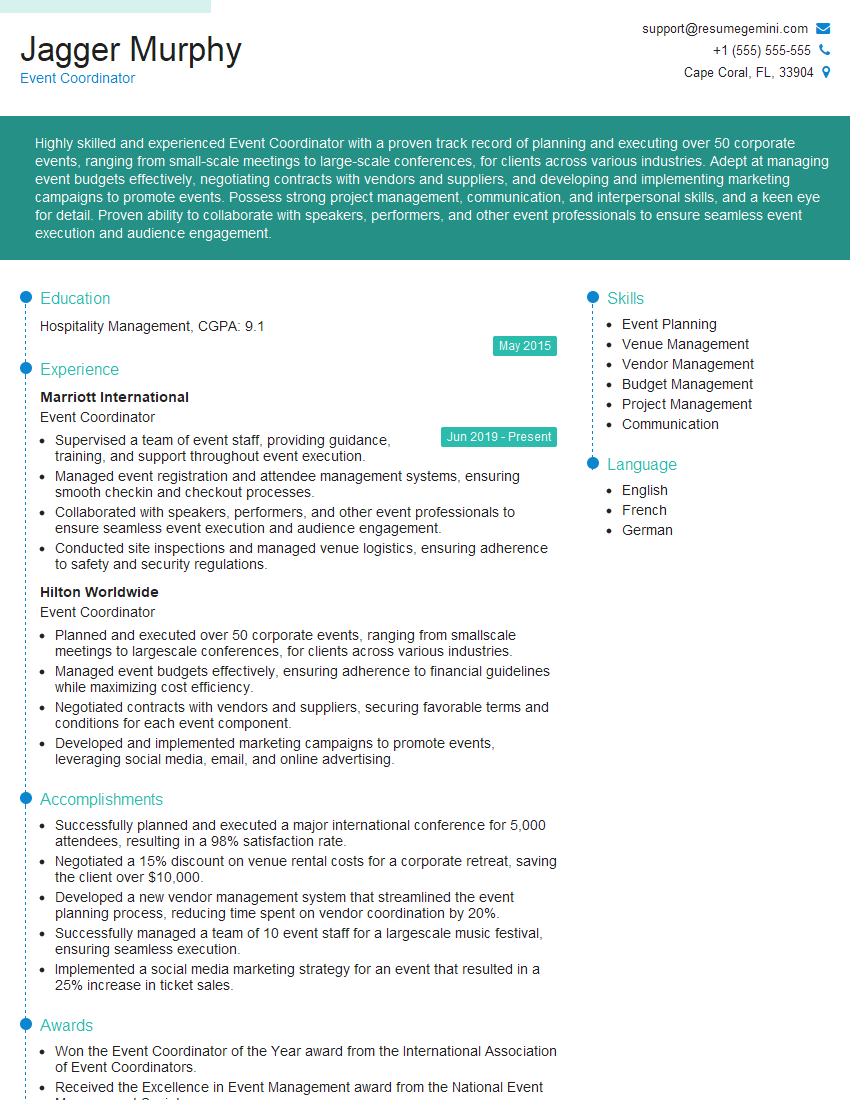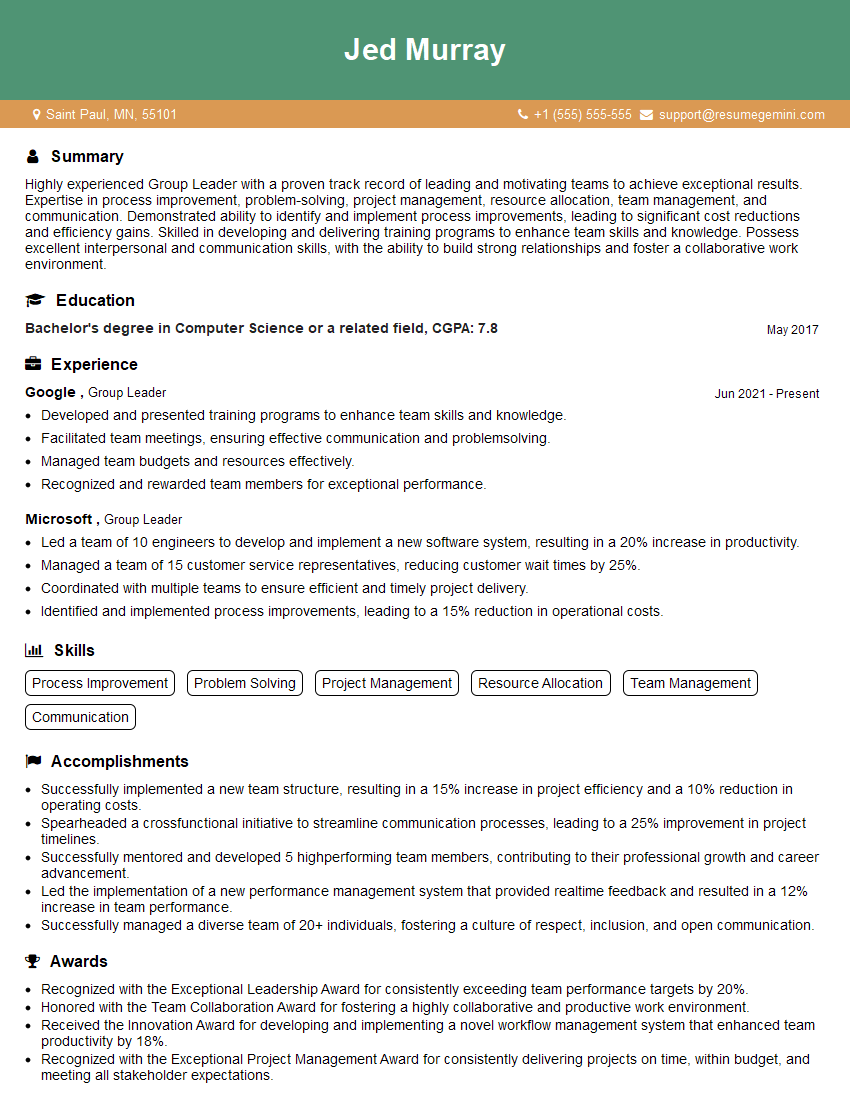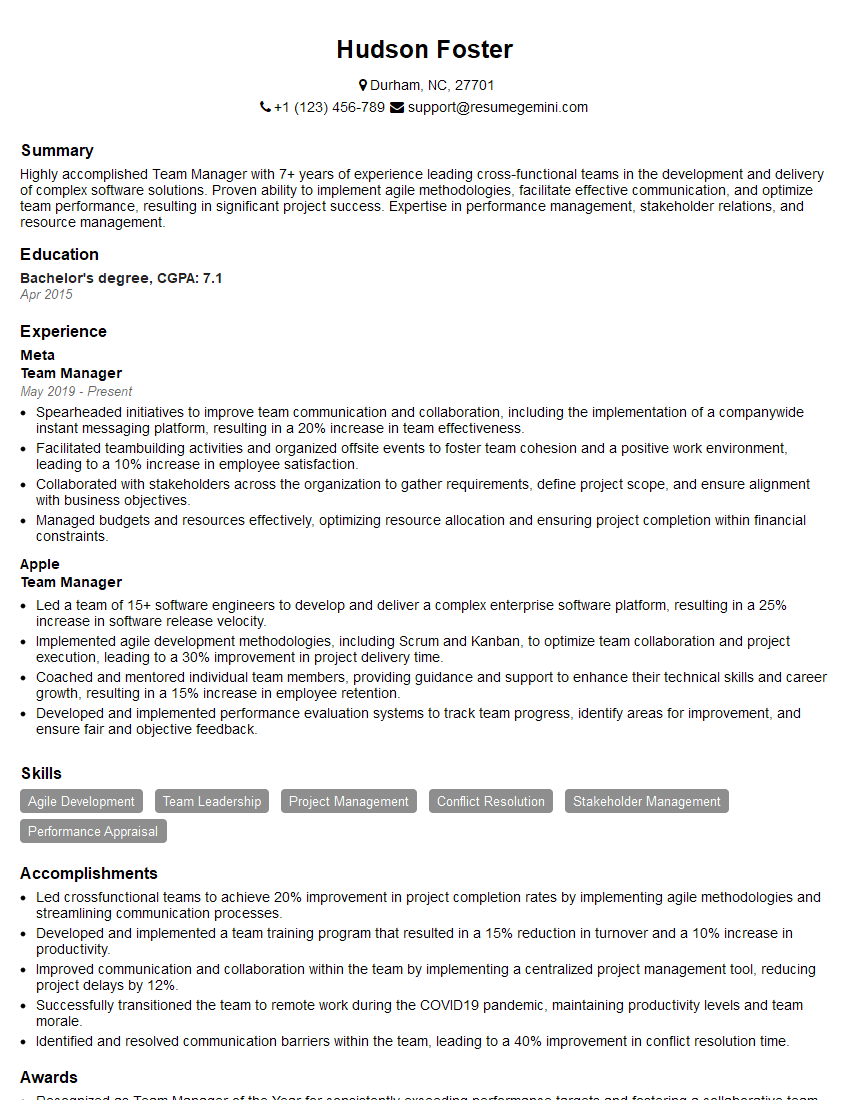Every successful interview starts with knowing what to expect. In this blog, we’ll take you through the top Team Management and Coordination interview questions, breaking them down with expert tips to help you deliver impactful answers. Step into your next interview fully prepared and ready to succeed.
Questions Asked in Team Management and Coordination Interview
Q 1. Describe your experience in delegating tasks effectively within a team.
Effective delegation is about assigning tasks to the right people at the right time, ensuring success and team member growth. It’s not just about dumping work; it’s about empowering individuals and optimizing the team’s overall performance. My approach involves a thorough understanding of each team member’s strengths, weaknesses, and workload.
- Assessment: I begin by assessing the task’s complexity, required skills, and deadlines.
- Matching: I then match the task to the team member best suited to handle it, considering their experience and capacity.
- Clear Communication: I provide clear instructions, outlining expectations, deadlines, and available resources. This includes open communication channels for questions and updates.
- Support & Monitoring: I offer support without micromanaging, regularly checking in on progress and offering guidance as needed. This shows trust and fosters a sense of ownership.
- Feedback & Recognition: I provide timely feedback, recognizing both achievements and areas for improvement. This reinforces positive behaviors and encourages growth.
For example, in a previous project involving website development, I didn’t just assign coding tasks arbitrarily. I identified one team member’s expertise in front-end development and another’s proficiency in back-end development. By delegating accordingly and providing clear guidelines, we completed the project on time and with high quality.
Q 2. How do you handle conflict resolution within a team environment?
Conflict is inevitable in teamwork, but how it’s handled determines team cohesion and productivity. My approach focuses on proactive conflict management and fostering a culture of open communication and mutual respect.
- Early Intervention: I encourage open communication and aim to address conflicts as soon as they arise before they escalate.
- Active Listening: I facilitate discussions where each party feels heard and understood. I ask clarifying questions to uncover underlying issues and perceptions.
- Collaboration & Compromise: I guide team members toward finding mutually acceptable solutions through collaborative problem-solving and compromise.
- Mediation (if necessary): If needed, I act as a neutral mediator, helping to de-escalate tensions and facilitate a productive discussion.
- Focus on Solutions: The focus should always remain on solving the problem, not on assigning blame.
In one instance, a disagreement arose between designers and developers regarding the feasibility of a design element. Instead of letting it fester, I facilitated a meeting where each side explained their perspective. By focusing on the project goals and exploring alternative solutions, we found a compromise that satisfied everyone.
Q 3. Explain your approach to motivating team members to achieve common goals.
Motivating a team involves creating a positive and supportive environment where individuals feel valued and empowered. It’s about connecting their work to a larger purpose and recognizing their contributions.
- Clear Goals & Expectations: Clearly defined goals and expectations provide direction and purpose, ensuring everyone is working towards the same objectives.
- Recognition & Appreciation: Recognizing and appreciating individual and team accomplishments boosts morale and reinforces positive behaviors.
- Empowerment & Autonomy: Allowing team members to take ownership of their tasks and make decisions increases their engagement and motivation.
- Open Communication & Feedback: Regular, constructive feedback and open communication create a supportive environment where team members feel heard and valued.
- Opportunities for Growth: Providing opportunities for professional development, skill enhancement, and advancement encourages growth and keeps team members engaged.
For example, on a challenging project with tight deadlines, I regularly acknowledged the team’s efforts and celebrated milestones. I also provided opportunities for skill development through workshops and mentorship programs. The result was a highly motivated and engaged team that not only met, but exceeded expectations.
Q 4. How do you measure the success of a team project?
Measuring the success of a team project goes beyond simply completing it on time and within budget. A holistic approach considers various factors to assess overall effectiveness and impact.
- Meeting Objectives: Did the project achieve its stated goals and objectives? This often involves quantifiable metrics such as increased sales, improved efficiency, or enhanced user engagement.
- On-Time & On-Budget Delivery: Did the project meet its deadlines and budget constraints? This demonstrates effective planning and execution.
- Quality of Work: Was the final product or service of high quality, meeting or exceeding expectations?
- Team Collaboration & Morale: Was the team able to collaborate effectively? Were team members satisfied with their experience?
- Impact & ROI: What was the overall impact of the project? Did it generate a positive return on investment?
For instance, in a software development project, success wasn’t solely measured by the launch date. We also tracked user engagement metrics such as daily active users and customer satisfaction scores. These metrics provided a comprehensive picture of the project’s success beyond simply completing the coding.
Q 5. What strategies do you employ to improve team communication and collaboration?
Effective team communication and collaboration are the cornerstones of successful project delivery. I employ several strategies to foster a collaborative and communicative team environment.
- Regular Team Meetings: Holding regular meetings (daily stand-ups, weekly progress updates) keeps everyone informed and aligned.
- Defined Communication Channels: Establishing clear communication channels (email, instant messaging, project management software) minimizes confusion and ensures timely information sharing.
- Collaborative Tools: Utilizing collaborative tools like shared documents, project management software, and version control systems improves transparency and streamlines workflow.
- Open Door Policy: Encouraging open communication where team members feel comfortable approaching me or their peers with questions or concerns fosters a supportive environment.
- Active Listening & Feedback: Actively listening to team members’ ideas and providing constructive feedback creates a sense of value and encourages participation.
For example, I once implemented a daily stand-up meeting combined with a project management tool. This simple combination significantly improved transparency, accountability and reduced the number of email exchanges considerably.
Q 6. Describe a time you had to manage a team under pressure. What was the outcome?
During a critical product launch, we faced a major setback when a key component failed just days before the launch date. The pressure was immense, as the launch was crucial for the company’s market positioning.
My response involved several key steps:
- Assess the Situation: I quickly assembled the core team to assess the severity of the problem and identify potential solutions.
- Prioritize Tasks: We prioritized tasks based on criticality, focusing on resolving the immediate issue while minimizing disruption to the overall launch plan.
- Delegate Responsibilities: I delegated responsibilities clearly, ensuring each team member understood their role and had the resources they needed.
- Maintain Communication: Frequent updates and open communication kept everyone informed and aligned, mitigating panic and fostering collaboration.
- Adapt & Problem Solve: We adapted the launch plan slightly to accommodate the setback and explored alternative solutions to ensure a successful launch.
Despite the unexpected challenge, we successfully launched the product with minimal disruption. This experience highlighted the importance of preparedness, clear communication, and strong team collaboration under pressure.
Q 7. How do you identify and address individual team member performance issues?
Addressing individual performance issues requires a sensitive yet firm approach that focuses on improvement and growth rather than punishment. My strategy involves a combination of observation, feedback, and support.
- Observation & Documentation: I closely observe the individual’s performance, documenting specific instances of underperformance or missed deadlines.
- Private Meeting & Feedback: I schedule a private meeting with the individual to discuss my observations, providing specific examples and constructive feedback. The focus is on helping them understand areas for improvement and offering support.
- Action Plan & Support: We work together to develop an action plan outlining specific steps to improve performance. This may include additional training, mentoring, or adjustment of responsibilities.
- Regular Check-ins: I conduct regular check-ins to monitor progress, offer ongoing support, and make necessary adjustments to the action plan.
- Documentation & HR (if necessary): If performance doesn’t improve despite support and intervention, I will escalate the issue to HR following company protocols.
For example, I once noticed a team member struggling with a specific technical skill. Instead of criticizing, I offered additional training and paired them with a more experienced colleague for mentorship. This approach led to significant improvement in their performance and increased their confidence.
Q 8. Explain your experience with different team management methodologies (Agile, Waterfall, etc.).
My experience spans both Agile and Waterfall methodologies, each suited to different project needs. Waterfall, with its linear, sequential approach, works well for projects with clearly defined requirements and minimal anticipated changes. I’ve used this successfully in software development projects where the scope was well-understood upfront. For example, I managed a team developing a core banking system where changes during development were extremely costly and disruptive. Strict adherence to Waterfall’s phases – requirements, design, implementation, testing, deployment – was crucial to success.
However, Agile methodologies, particularly Scrum and Kanban, are my preference for most projects due to their adaptability. Agile embraces iterative development, frequent feedback loops, and continuous improvement. In a recent project involving a mobile app development, we adopted Scrum. The iterative sprints allowed us to incorporate user feedback early and often, leading to a superior final product. We held daily stand-up meetings, sprint reviews, and retrospectives to ensure transparency and continuous improvement. This fostered collaboration and allowed us to swiftly adapt to evolving market demands and user feedback.
Q 9. How do you foster a positive and productive team environment?
Fostering a positive and productive team environment involves a multifaceted approach. It starts with clear communication: establishing regular communication channels, holding team meetings, and encouraging open dialogue. I believe in creating a culture of trust and psychological safety, where team members feel comfortable sharing ideas, concerns, and even mistakes without fear of retribution. Recognition and appreciation are essential – celebrating successes, both big and small, boosts morale and reinforces positive behaviors. This could involve a simple ‘thank you’ or a more formal recognition program depending on company culture.
Furthermore, I focus on building strong relationships within the team. Team-building activities, both work-related and social, help to foster camaraderie and improve collaboration. Finally, promoting work-life balance is critical for employee well-being and overall productivity. Encouraging employees to take breaks, utilize vacation time, and prioritize their personal lives can reduce stress and improve performance.
Q 10. How do you handle disagreements or differing opinions within your team?
Disagreements are inevitable in any team, and I view them as opportunities for growth and innovation. My approach begins with active listening – ensuring each team member feels heard and understood. I facilitate constructive dialogue by encouraging everyone to express their perspectives clearly and respectfully, focusing on the issues rather than personalities. I employ collaborative problem-solving techniques, such as brainstorming or mind-mapping, to explore different solutions and find common ground.
If a consensus cannot be reached, I might use a decision-making framework like weighted voting or a formal process to determine the best course of action. Transparency is key throughout this process; I ensure the team understands the rationale behind the final decision, regardless of their individual viewpoints. The goal is not to eliminate disagreements but to manage them effectively, transforming potential conflict into productive collaboration.
Q 11. Describe a time you had to make a difficult decision impacting your team. What was the process?
One challenging decision involved restructuring a project team mid-way through a complex software development project. Initial progress was slow due to a lack of clear roles and responsibilities. My process began with thorough data gathering: analyzing project performance, conducting individual interviews with team members, and assessing individual strengths and weaknesses. This provided a clear picture of the underlying issues.
Next, I developed several potential solutions, including restructuring the team, reallocating tasks, or bringing in additional resources. I presented these options to the team, explaining the rationale behind each and soliciting their feedback. After careful consideration and team input, we opted for a partial restructuring, reassigning some roles and clarifying responsibilities. This decision, although difficult initially, resulted in significantly improved productivity and project delivery. Regular check-ins and transparent communication throughout the process were vital in minimizing disruption and maintaining team morale.
Q 12. How do you prioritize tasks and manage competing deadlines within a team setting?
Prioritizing tasks and managing competing deadlines requires a structured approach. I typically start by using a project management tool (like Jira or Asana) to create a central repository for all tasks, deadlines, and dependencies. Then, I work with the team to prioritize tasks using a framework like MoSCoW (Must have, Should have, Could have, Won’t have) or by assigning priority levels based on business value and urgency.
This involves considering factors like dependencies between tasks, resource availability, and potential risks. We use techniques like Kanban boards to visualize the workflow and identify potential bottlenecks. Regular progress meetings, coupled with transparent communication about potential delays or resource conflicts, help to keep the team on track and mitigate risks effectively. Contingency planning for potential delays is also crucial – having alternative strategies in place helps us to remain adaptable and minimize the impact of unforeseen circumstances.
Q 13. How do you ensure accountability within your team?
Accountability is fostered through a combination of clear expectations, regular feedback, and transparent performance tracking. I begin by ensuring that each team member has a clear understanding of their roles, responsibilities, and performance goals. These are documented and regularly reviewed. We use a system of regular check-ins (weekly or bi-weekly, depending on project needs) to monitor progress, discuss challenges, and celebrate successes.
Progress tracking involves using project management tools to monitor task completion, deadlines, and overall project progress. This transparency allows everyone to see where we stand and identify areas needing attention. Addressing performance issues promptly and directly, offering support and guidance rather than just criticism, is crucial. Constructive feedback, coupled with clear expectations and consistent monitoring, creates a culture of accountability where everyone takes ownership of their work and contributes to the team’s overall success.
Q 14. How do you provide constructive feedback to team members?
Providing constructive feedback is a crucial aspect of effective team management. My approach focuses on being specific, timely, and balanced. I avoid generalizations and instead focus on observable behaviors and their impact. For example, instead of saying ‘you’re not a team player,’ I might say, ‘I noticed you didn’t participate in the last brainstorming session, which limited our ability to explore diverse solutions.’ This is more specific and actionable.
I structure feedback using the SBI model (Situation, Behavior, Impact) to clarify the context, describe the behavior, and explain the consequences. I also strive to create a safe space for feedback by focusing on the behavior, not the person, and framing feedback as an opportunity for growth. Finally, I always end with positive reinforcement, highlighting the individual’s strengths and contributions. The goal is not to criticize but to help team members improve and reach their full potential.
Q 15. What tools or technologies do you use to manage and coordinate teams?
Effective team management and coordination require a robust technological toolkit. My approach is multifaceted and adapts to project needs. I leverage project management software like Jira and Asana for task assignment, progress tracking, and deadline management. These platforms facilitate clear communication and visibility into individual and team contributions. For real-time collaboration and quick queries, I utilize communication tools such as Slack or Microsoft Teams. These platforms allow for instant messaging, file sharing, and video conferencing, fostering a dynamic and responsive team environment. Finally, for documentation and knowledge sharing, I rely on platforms like Confluence or Google Workspace, ensuring information is readily accessible and consistently updated. The specific tools I choose depend on the project’s size, complexity, and the team’s familiarity with different platforms.
- Jira: Ideal for complex projects with many dependencies, offering Kanban and Scrum boards for agile development.
- Asana: A more versatile platform suitable for various project types, offering excellent task management and collaboration features.
- Slack/Microsoft Teams: Crucial for immediate communication and quick problem-solving within the team.
- Confluence/Google Workspace: Essential for centralized documentation, knowledge bases, and shared resources.
Career Expert Tips:
- Ace those interviews! Prepare effectively by reviewing the Top 50 Most Common Interview Questions on ResumeGemini.
- Navigate your job search with confidence! Explore a wide range of Career Tips on ResumeGemini. Learn about common challenges and recommendations to overcome them.
- Craft the perfect resume! Master the Art of Resume Writing with ResumeGemini’s guide. Showcase your unique qualifications and achievements effectively.
- Don’t miss out on holiday savings! Build your dream resume with ResumeGemini’s ATS optimized templates.
Q 16. How do you adapt your management style to different team members and personalities?
Adaptability is paramount in team management. I believe in a situational leadership style, adjusting my approach based on individual team members’ strengths, weaknesses, and preferred communication styles. Some team members thrive with detailed instructions and close supervision, while others prefer more autonomy and independence. I assess each team member’s personality and work style through observation, feedback sessions, and one-on-one conversations. For example, with a highly independent and creative team member, I’ll focus on setting clear goals and providing constructive feedback, allowing them to explore innovative solutions. In contrast, for a team member who needs more guidance, I provide more structured support, regular check-ins, and clear expectations. This personalized approach fosters a supportive and inclusive environment where every team member can reach their full potential. This is achieved through active listening, understanding individual needs, and providing the appropriate level of support and guidance.
Q 17. Describe a time you had to mentor or train a new team member.
I recently mentored a junior developer new to our team. They possessed strong technical skills but lacked experience in our specific development methodology and project workflows. My approach involved a phased training plan. First, I paired them with a senior team member for shadowing and hands-on experience, allowing for guided learning and immediate feedback. Next, I conducted regular one-on-one sessions to discuss their progress, address challenges, and provide constructive criticism. I also assigned them tasks that gradually increased in complexity, allowing for a gradual transition to independent work. We used our project management software to track their tasks and progress, ensuring consistent monitoring and support. The key was building trust and a comfortable learning environment. By the end of the training period, they were a fully integrated and contributing member of the team.
Q 18. How do you handle situations where team members underperform?
Addressing underperformance requires a structured and empathetic approach. I begin by having a private, constructive conversation with the individual. This conversation focuses on understanding the root cause of the underperformance. Is it due to lack of training, unclear expectations, personal issues, or something else? Once the root cause is identified, I collaborate with the team member to create an improvement plan. This plan includes specific, measurable, achievable, relevant, and time-bound (SMART) goals. I provide additional training, resources, or mentoring as needed. Regular check-ins are crucial to monitor progress and provide ongoing support. If improvement is not seen despite these efforts, more serious steps may be necessary, potentially involving HR and performance management processes. The goal is always to support the individual’s growth and development while ensuring the team’s overall performance.
Q 19. How do you build trust and rapport within your team?
Building trust and rapport within a team is a continuous process that starts with fostering open communication. I encourage regular team meetings, both formal and informal, to facilitate communication and collaboration. I actively listen to team members’ concerns and feedback, demonstrating respect for their perspectives. I also celebrate successes, both big and small, to boost morale and reinforce positive behavior. Transparency is key – I ensure team members are aware of project goals, challenges, and progress. Finally, I lead by example, demonstrating integrity, accountability, and commitment to the team’s success. Creating a safe space for open dialogue, constructive feedback, and mutual support builds a strong foundation of trust and camaraderie. I also encourage team-building activities, both inside and outside of the work environment, to foster relationships and strengthen bonds.
Q 20. Describe your experience with remote team management.
My experience with remote team management highlights the critical role of communication and technology. I’ve successfully managed remote teams using a combination of asynchronous and synchronous communication methods. Asynchronous communication, such as email and project management software updates, allows team members to work independently and at their own pace. Synchronous communication, such as video conferencing and instant messaging, facilitates real-time collaboration and problem-solving. Regular virtual check-ins and team meetings are essential to maintain team cohesion and address any challenges. Utilizing project management tools with robust reporting features allows for consistent monitoring of individual and team progress. Building trust and rapport in a remote environment requires extra effort, but it’s achievable through regular communication, transparency, and demonstrating empathy and understanding for the unique challenges of remote work. Over-communication, rather than under-communication, is key to success.
Q 21. How do you measure team performance and identify areas for improvement?
Measuring team performance involves a multi-faceted approach. I use both qualitative and quantitative metrics. Quantitative metrics might include project completion rates, on-time delivery, defect rates, and customer satisfaction scores. Qualitative metrics include team collaboration, communication effectiveness, problem-solving skills, and individual growth. Regular feedback sessions, both individual and team-based, are crucial for identifying areas for improvement. I use data from project management tools, performance reviews, and customer feedback to gain a comprehensive understanding of team performance. This data-driven approach enables me to identify strengths and weaknesses, inform decision-making, and design targeted improvement initiatives. Furthermore, regular retrospectives, where the team reflects on past projects and identifies areas for enhancement, are essential for continuous improvement.
Q 22. How do you ensure team members understand their roles and responsibilities?
Ensuring team members understand their roles and responsibilities is paramount for effective teamwork. It’s not enough to simply assign tasks; clear communication and ongoing reinforcement are crucial. I begin by creating a detailed Role Clarity Document for each team member. This document outlines their specific responsibilities, key performance indicators (KPIs), reporting lines, and any relevant authorities or decision-making powers.
Further, I use a combination of methods to ensure comprehension:
- One-on-one meetings: I schedule individual meetings to discuss the Role Clarity Document, answer questions, and address any concerns. This allows for personalized clarification and ensures everyone understands their unique contribution.
- Team workshops: These interactive sessions facilitate open discussion, enabling team members to learn from each other and understand the interconnectedness of their roles.
- Regular check-ins: I conduct regular check-ins, both individually and as a team, to monitor progress, identify any roadblocks, and proactively address any confusion about roles and responsibilities. This ensures that everyone remains aligned and informed.
- Visual aids: Using diagrams like org charts or process flowcharts can help visualize the team structure and individual roles within the broader organizational context.
For instance, in a previous project managing a software development team, I used a Kanban board to visually represent tasks and responsibilities, clarifying who was accountable for each stage of development. This fostered transparency and reduced misunderstandings.
Q 23. How do you facilitate effective team meetings?
Effective team meetings are crucial for collaboration and progress. I structure meetings to maximize productivity and engagement. My approach involves:
- Clear agenda and objectives: Before each meeting, I distribute a clear agenda outlining the topics to be discussed, desired outcomes, and allocated time for each item. This ensures everyone is prepared and focused.
- Structured format: I follow a structured format, typically starting with a brief recap of previous actions, then addressing agenda items in a logical sequence. I encourage active participation and manage time effectively.
- Actionable outcomes: Each meeting concludes with clear action items assigned to specific individuals with deadlines. These are documented and circulated to ensure accountability.
- Rotating roles: To foster inclusivity and skill development, I rotate roles like note-taking and agenda preparation amongst team members.
- Regular feedback: I solicit feedback regularly on the effectiveness of the meetings, adapting the format and approach based on team input.
For example, in a previous project dealing with a complex marketing campaign launch, I implemented a ‘stand-up’ style meeting to keep communication concise and focus on immediate action items. This saved significant time and improved efficiency compared to longer, less focused meetings.
Q 24. Describe a time you had to manage a crisis within a team.
In a previous role, we faced a major crisis when a critical server malfunctioned, causing a significant outage in our e-commerce platform. This resulted in lost sales and customer frustration. My response involved a multi-pronged approach:
- Immediate damage control: I first ensured all team members were aware of the situation and the urgency. We focused on immediate actions – restoring the server, informing customers, and implementing temporary solutions.
- Root cause analysis: Once the immediate crisis was under control, we conducted a thorough investigation to identify the root cause of the server failure. This included analyzing logs and reviewing maintenance procedures.
- Team communication and support: I maintained open communication, keeping the team informed of progress and addressing their concerns. This fostered a sense of collaboration and prevented panic.
- Implementing preventive measures: Based on our analysis, we implemented several preventive measures to prevent future outages, including enhanced server monitoring, improved backup systems, and stricter maintenance protocols.
- Post-mortem review: After the situation was resolved, we conducted a post-mortem review to analyze our response and identify areas for improvement in our crisis management plan.
The experience highlighted the importance of proactive planning, effective communication, and a well-defined crisis management strategy. It also underscored the need for a supportive team environment, where individuals feel empowered to contribute during challenging times.
Q 25. How do you ensure alignment of team goals with organizational objectives?
Aligning team goals with organizational objectives is essential for overall success. I achieve this alignment through several strategies:
- Understanding the organizational strategy: I begin by thoroughly understanding the organization’s overall strategic goals and objectives. This involves studying strategic plans, attending relevant meetings, and engaging in discussions with senior management.
- Translating organizational objectives into team goals: Once I understand the organizational strategy, I work with my team to translate these broad objectives into specific, measurable, achievable, relevant, and time-bound (SMART) team goals.
- Regular communication and feedback loops: I maintain open communication with both the team and senior management, providing regular updates on progress and actively soliciting feedback. This ensures we remain aligned and address any misalignments promptly.
- Performance monitoring and adjustments: I regularly monitor team performance against the established goals and make necessary adjustments to ensure we remain on track. This might involve reassessing goals, reallocating resources, or adjusting strategies.
- Celebrating successes: Acknowledging and celebrating successes along the way reinforces the importance of the team’s contribution to the larger organizational goals and motivates the team.
For example, when working on a project with a specific revenue target, I clearly outlined how the team’s deliverables directly contributed to achieving that target. This provided context and motivation for the team.
Q 26. How do you handle situations where team members are resistant to change?
Resistance to change is a common challenge in team management. My approach focuses on understanding the root cause of the resistance and addressing it empathetically and strategically:
- Understanding the reasons for resistance: I first seek to understand the reasons behind the resistance. This involves active listening, open communication, and empathy. Sometimes, resistance stems from fear of the unknown, lack of understanding, or concerns about job security.
- Open communication and transparency: I proactively communicate the reasons for the change, the benefits it will bring, and the potential challenges. Transparency helps alleviate fears and build trust.
- Involving the team in the process: Whenever possible, I involve the team in the change process. This allows them to contribute ideas, voice concerns, and feel ownership of the change.
- Addressing concerns and providing support: I actively address the concerns of team members, providing support and resources to help them adapt to the change. This might include training, mentoring, or additional support.
- Celebrating early successes: Celebrating small wins along the way demonstrates progress and builds momentum, reducing resistance.
For example, when introducing a new project management software, I held workshops to demonstrate its benefits, addressed team concerns about the learning curve, and provided individual training sessions. This resulted in a smoother transition and higher adoption rate.
Q 27. What are your strengths and weaknesses as a team manager?
My strengths as a team manager include strong communication skills, a collaborative leadership style, and a proactive approach to problem-solving. I’m adept at building strong relationships, fostering a positive team environment, and delegating effectively. I also have a proven ability to motivate teams and achieve ambitious goals.
However, I recognize that like everyone, I have areas for improvement. One area I’m actively working on is delegation. While I am good at delegating, I sometimes find it challenging to fully relinquish control and trust the team to handle tasks independently. I’m addressing this by consciously practicing more hands-off management and focusing on providing guidance and support rather than micromanaging.
Q 28. How do you maintain work-life balance while managing a team?
Maintaining work-life balance while managing a team requires conscious effort and effective time management. My strategies include:
- Prioritization and time management: I utilize time management techniques such as prioritization matrices and time blocking to focus on high-impact tasks and avoid multitasking.
- Delegation: I effectively delegate tasks, empowering team members to take ownership and build their skills.
- Setting boundaries: I set clear boundaries between work and personal life, avoiding checking emails or working outside of designated hours whenever possible.
- Regular breaks and self-care: I prioritize regular breaks throughout the day, engaging in activities that promote relaxation and well-being.
- Open communication: I openly communicate my boundaries and expectations with my team, fostering mutual respect and understanding.
For instance, I schedule specific times for checking emails and responding to messages, avoiding constant interruptions. I also make sure to take a break for lunch away from my desk and engage in regular exercise to maintain my physical and mental health.
Key Topics to Learn for Team Management and Coordination Interview
- Team Dynamics and Communication: Understanding different team personalities, communication styles, and conflict resolution strategies. Practical application: Describe a situation where you successfully navigated a team conflict and the techniques you employed.
- Delegation and Empowerment: Effectively assigning tasks, providing support, and fostering individual growth within a team. Practical application: Explain your approach to delegating tasks, considering individual strengths and skill sets. How do you ensure accountability?
- Project Management Methodologies: Familiarity with Agile, Waterfall, or other project management frameworks. Practical application: Discuss a project you managed using a specific methodology and the results achieved.
- Motivation and Leadership Styles: Exploring different leadership styles (transformational, transactional, servant leadership) and their application in motivating teams to achieve goals. Practical application: Describe your leadership style and how it has impacted team performance.
- Performance Management and Feedback: Setting clear expectations, providing constructive feedback, and conducting performance reviews. Practical application: Outline your approach to delivering both positive and negative feedback to team members.
- Goal Setting and Prioritization: Establishing SMART goals, prioritizing tasks effectively, and monitoring progress. Practical application: Explain how you would approach prioritizing competing project demands with limited resources.
- Team Building and Collaboration: Fostering a positive and collaborative team environment. Practical application: Describe activities or strategies you have used to build team cohesion and improve collaboration.
Next Steps
Mastering Team Management and Coordination is crucial for career advancement, opening doors to leadership roles and increased responsibility. A strong resume is your first step towards showcasing these valuable skills. Creating an ATS-friendly resume is essential to ensure your application gets noticed by recruiters. ResumeGemini can help you build a professional and impactful resume that highlights your team management capabilities. We provide examples of resumes tailored to Team Management and Coordination to guide you in crafting a compelling application that lands you your dream job.
Explore more articles
Users Rating of Our Blogs
Share Your Experience
We value your feedback! Please rate our content and share your thoughts (optional).
What Readers Say About Our Blog
Hi, I’m Jay, we have a few potential clients that are interested in your services, thought you might be a good fit. I’d love to talk about the details, when do you have time to talk?
Best,
Jay
Founder | CEO








